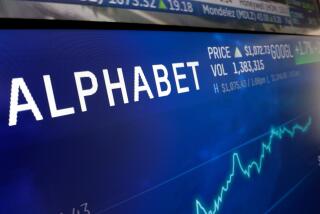Intel Profit Leaps Beyond Forecasts as Sales Soar 41%
- Share via
Boosted by robust sales in Asia as well as hearty demand for personal computers among businesses, Intel Corp.’s profit more than doubled in the fourth quarter, the company said Tuesday, giving the chip giant its seventh consecutive year of record earnings and exceeding even the most optimistic Wall Street projections.
Santa Clara, Calif.-based Intel posted net income of $1.91 billion, or $2.13 a share, for the quarter ended Dec. 30, giving it a profit of $5.2 billion, or $5.81 a share, for the year. Quarterly revenue increased by a healthy 41% to $6.44 billion, bringing Intel’s 1996 revenue to $20.8 billion, a 44% rise from 1995.
Analysts had predicted a strong quarter for Intel, which makes microprocessors, the engine of nearly 80% of the PCs on the market today. But the company again easily surpassed Wall Street’s projections, which averaged $1.84 a share.
Intel’s quarterly financial results are considered a barometer of the computer industry’s health. Despite a lackluster fourth quarter for many of its customers, Intel was bothered little by sluggish holiday PC sales, making up for the shortfall with a formidable international sales effort and corporate hardware purchases.
Intel benefited from a surge in PC purchases by businesses of all sizes that eagerly snapped up more powerful hardware to establish connections to the Internet. In addition, Intel’s microprocessor sales in Asia have nearly doubled from 16% of revenue two years ago to a current 30%, an indication that the technology revolution is spreading to what were once remote corners of the globe.
“The year 1996 really was the year of Asia Pacific,” said Intel Vice President Paul Otellini. “The economies in that part of the world are booming. The growth in non-U.S. markets is outpacing domestic.”
Intel announced its results after stock markets closed. Its shares ended a day of active trading up 25 cents at $147.125 on Nasdaq, after trading at a record high of $149.75. Intel said its board of directors approved a 2-for-1 stock split, which will be voted on at the May 21 shareholders meeting.
“For Intel, the story is up and to the right,” said Jon Joseph, a financial analyst at Montgomery Securities, a San Francisco investment bank specializing in technology. “What we have to keep an eye on are gross margins.”
Gross margins--sales minus the cost of goods sold--soared to 63% in the quarter from 57.2% in the previous quarter. Intel executives attributed the increase to greater sales of its highest-performance chips--the type used in computer servers that orchestrate the workings of PC networks--as well as its decision to not cut chip prices early in the quarter, as it traditionally has.
In what was the only sour note, Intel said the current quarter is unlikely to be as strong as the preceding. Revenue will be flat with the fourth quarter, gross margins are expected to settle down to the 50% range and expenses will increase by between 4% and 5%, executives said.
Capital spending will increase to $4.5 billion in 1997, compared with $3 billion last year, mostly to complete construction on two chip fabrication plants and to start building a third. Expenses in the first quarter will rise to $1.2 billion, the company said.
While keeping a close watch for any serious gross margin erosion, analysts said the company’s inability to sustain the spectacular financial performance achieved during the fourth quarter is natural. “After a blowout quarter like this one, it’s to be expected,” Joseph said.
In a rare show of corporate largess, Intel shared its good fortune with its 48,500 employees, awarding each a $1,000 bonus.






